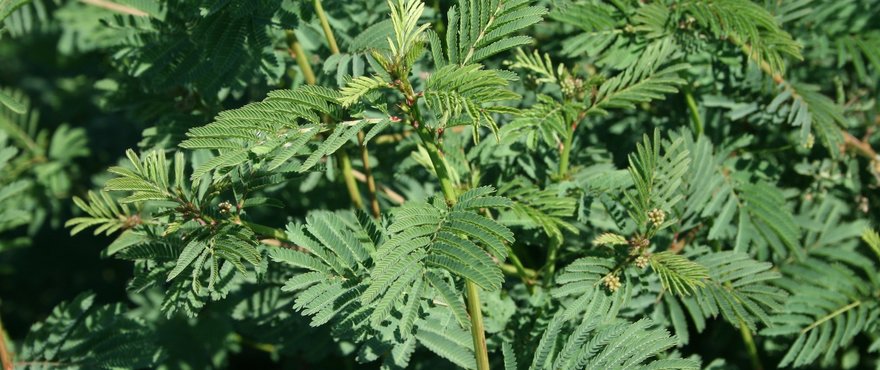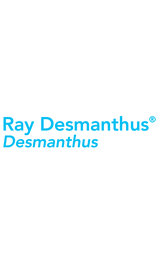Download a copy of the Ray Desmanthus fact sheet.
Ray Desmanthus® is a completely new variety of desmanthus bred in Australia. This highly productive, drought tolerant perennial legume is very palatable to livestock, has a high digestibility and protein content and does not cause bloat. Ray produces high amounts of forage yield from its strongly erect and upright growth habit. Unlike other desmanthus varieties, Ray remains very fine in the stem and has stay green traits that help maintain feed quality and reduce the amount of unpalatable woodiness expressed in the plant as it matures. Being later flowering (42 days later than cv. Marc) allows Ray to produce higher quality feed later into the growing season, with the finer softer appearance of the plant resulting in Ray often being labelled as a ‘tropical lucerne’ or ‘mini leucaena’.
Key features
- Highly palatable, non-toxic tropical legume (no mimosine)
- Ideally suited to and highly productive in heavy clay soils
- Excellent persistence — robust, woody base and protected main growing crown
- Drought tolerant — deep tap rooted perennial able to access moisture
- Tolerant to frost and heavy grazing
- Exceptional persistence — recruits readily from seed and regenerates from the crown
- No requirement for height management
- Suitable for addition to stock licks and animal supplements
- Australian bred for Australian conditions
Agronomy and management
Ray Desmanthus® is well suited to medium to heavier clay soils in the drier tropical and sub-tropical regions, Ray is also naturally adapted to drier, harsher, lower soil fertility conditions. Will tolerate many soil types from sandy/gravel soils through to heavier rock clays but best adapted to heavy textured clay soils with neutral to alkaline pH, such as brigalow clays, open downs and heavier alluvial soils. Currently there are few tropical legume species available for sowing in heavy soils, however, Ray Desmanthus® is an ideal option for this exact scenario. Can tolerate some levels of acidic, sodic and saline soils. Tolerant of mild frosts and cooler conditions, it is defoliated by heavy frosts but will regrow from the crown after rain in early spring.
Establishment
Ray Desmanthus® seed has been scarified to increase germination rates and assist in establishment in the first season. Planting should occur from early spring right through until mid-summer (into late March for Central Queensland). Seed should be planted when soil temperature exceeds 16ºC. Seed can be drilled or broadcast and being a small seed, should be planted ideally at 5mm and no more than 1cm deep. Ray Desmanthus® can be planted into cultivation as well as oversowing existing grass pastures using a bandseeder or during renovation passes. Dropping legume seed directly on top of established grass pastures is not ideal and considered a high-risk activity with low success rates of establishment. The use of press wheels or, on non-hard setting soils rolling after sowing, will greatly improve germination and establishment by providing ample seed to soil contact. Follow up rain post planting is ideal.
Care should be taken not to plant in the hottest summer weather without adequate moisture – the seed must maintain close contact with wet soil for about 3–4 days to establish a seedling. Monitor conditions if harrowing after sowing to ensure that the small desmanthus seed is not being buried too deep as the seedling may not have the energy to emerge and establish. The use of AgriCote coated seed will greatly improve the establishment success of Ray Desmanthus®.
Fertiliser / nutrition
The use of AgriCote coated seed ensures essential macro and micronutrients are immediately available to the seedling, along with a specific, compatible rhizobia strain for nitrogen fixation (CB3126). Responds strongly to phosphorus, zinc and sulfur. Desmanthus planted in soils with low phosphorus would benefit from an application of superphosphate, which would also address any sulfur deficiency. The use of a soil test will form the foundation of a suitable fertiliser program. Inoculating seed with a compatible rhizobia inoculant is vital to promote nodulation for nitrogen fixation to facilitate plant requirements of nitrogen.
Growth habit
Ray Desmanthus® is an erect, herbaceous perennial shrub, strongly branched from the base, with a deep taproot and being fern-like in appearance. Soft to touch, stems are hairless, stay green and are less woody than other varieties, growing up to 1−1.5m tall. Ray Desmanthus® has a limited ability to spread, with plant populations thickening in planted areas and slowly spread from seedling recruits. Some ingestion of ripe pods from livestock can aid in spreading seed to other areas.
Compatibility (with other species)
Ray Desmanthus® performs extremely well in combination with perennial tropical and sub-tropical grasses, including Buffels, Bambatsi panic, Digitaria, Rhodes grass, Gatton panic, Guinea grass and Bluegrasses, including QLD Bluegrass. Combines well with other shrubby and twining pasture legumes such as Burgundy bean, Siratro, Butterfly pea, Stylo and Glycine.
Uses
Mainly used as a long-lived legume component of native or improved tropical or sub-tropical grazing permanent pasture systems. Can be used in alley farming systems as a hedgerow species.
Persistence
Ray Desmanthus® is a drought hardy, persistent perennial due to its robust root system that can reach more than one metre long into the soil, accessing soil moisture well beyond the shallow root systems of pasture grass species. Once Ray Desmanthus® has had the ability to set seed in the first year, plant recruitment occurs from both regrowth from existing established plants and seedling recruitment. A prolific seeding ability allows Ray to recruit readily from a highly loaded seed bank in the soil. Ray Desmanthus® has the ability to continually produce new shoots following grazing/cutting, with best regrowth being obtained when plants are fully established due to its capacity to store food reserves in the roots to facilitate production of new shoots. Desmanthus has been reported to persist successfully in established grass pasture systems for over 20 years.
Toxicity
Ray Desmanthus® does not cause bloat. No record of toxicity in any livestock species. Does contain relatively high tannin levels within the plant.
Management
The success of a pasture will depend on grazing management in the first season. Do not graze until seedlings have developed a strong root system. Ideally, avoid grazing until plants have had an opportunity to flower and set seed in the first season. Ray Desmanthus® can seed heavily under rotational grazing, allowing the stand to thicken up from new seedlings, while providing a good soil seed reserve which compensates for plant death in older stands. However, because the hard seed requires weathering to soften, seedling recruitment may be delayed for up to two years following seed set. When grazing or cutting established plants, care should be taken to leave around 10cm of growth for best results for regrowth and limit plant damage. Due to its high palatability, management intervention may be required to ensure that Ray Desmanthus® has periodic opportunities to set seed, particularly in younger stands in order to allow a hard seed bank to develop in the soil. The first 3−4 years are important for the longevity of desmanthus in a mix as any seed set will remain dormant for extended periods of time.
Plant Breeders Rights (PBR): This variety is registered under Plant Breeders Rights (PBR) in Australia. Unauthorised commercial propagation or any sale, conditioning, export, import or stocking of propagating material is an infringement under the Plant Breeders Rights Act (1994). Any breach of this legislation will leave the grower liable for prosecution.
Disclaimer: The information presented in this brochure is from official and other sources and is considered to be reliable. It is provided in good faith and every care has been taken to ensure its accuracy. Barenbrug does not accept any responsibility for the consequences that may arise from the acceptance of recommendations or the suggestions made.



